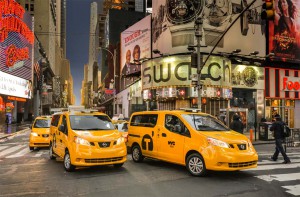If you can make it there you can make it anywhere, or so Nissan is hoping as it gets ready to put the first of its NV200-based cabs out onto the sometimes mean streets of New York.
After a long and contentious debate, that included a series of legal challenges, the Big Apple’s Taxi & Limousine Commission has set April 20, 2015 as the start date for its Taxi of Tomorrow program. With only rare exception, most of the current New York cab fleet will have to be replaced when they retire with specially modified Nissan NV200 vans.
The Japanese maker won a three-way shoot-out three years ago to replace the long-familiar Ford Crown Victoria as the taxi of choice for New York’s big yellow fleet. Proponents claim the new NV200 cab conversion offers a number of advantages, including more room and better visibility for passengers, and improved fuel economy for fleet operators.
But, perhaps in typical New York fashion, the city’s pick was challenged in a series of court cases that, at one point saw the Manhattan Supreme Court toss out the decision backed by former Mayor Michael Bloomberg. Eventually, that decision was reversed and Nissan was given the go-ahead – though fleet operators will have the option to choose an alternate hybrid of wheelchair accessible vehicle.
Nissan has teamed up with BraunAbility, an automotive mobility company to provide a wheelchair accessible version of the NV200.
The Big Apple has actually been increasing the number of cabs on its streets to improve access for the mobility impaired, eventually hoping to have as many as 15,000 or more licensed vehicles – with thousands more gypsy cabs and a growing number of operators participating in such alternatives as Lyft and Uber, the latter not required to adopt the Nissan NV200.
(U.S. new, used car sales will top record $1.1 trillion for 2014. Click Here for the story.)
Even then, the plan to replace the 16 different cab models currently in use is expected to be worth as much as $1 billion.
The choice of the Japanese van came after a three-year face-off that eventually was narrowed down to three alternatives, including the Ford Escape and a wildcard entry from Turkish start-up Karsan Otomotiv.
Nissan’s option featured not only a large interior, but such niceties as odor absorbing materials in the vehicle’s headliner, sliding doors, reading and foot lights, USB charging ports and 12-volt electrical outlets. Drivers also will have standard GPS and backup cameras.
(Falling gas prices putting money in consumers’ pockets. Click Here for the latest.)
Part of the challenge any new entry would face is the rough condition of New York roads.
“Nissan created its own ‘New York Ave.’ at its Arizona proving grounds to replicate harsh conditions of NYC streets to rigorously test the Nissan NV200 taxi to tune the suspension specifically to NYC road conditions,” the maker notes.
It also hired a number of cabbies to test early prototypes of the Taxi of Tomorrow on the real streets of New York, the maker claiming to have logged enough miles to have covered every street in crowded Manhattan 300 times.
Whether it will live up to expectations will soon become apparent. With an average 600,000 riders a day, the Taxi of Tomorrow will face a tough challenge every day.
(New car sales look solid as year comes to a close. Click Here for the story.)


This should be an interesting experiment. I’m not so sure giving one company the entire taxi contract is a good thing but time will tell. If there is any means possible for corruption, I’m certain that it will occur.
As far as taxi service is concerned I’ve seen numerous ideas including using the Prius. I expect that tax payers are subsidizing many of these alternative approaches to taxi service – as usual.